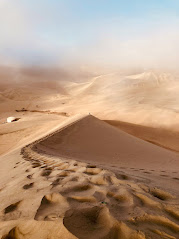Refreshing visit to Huacachina oasis and nearby Pisco winery
Refreshing visit to Huacachina oasis and nearby Pisco winery
Huacachina Oasis, near the city of Ica in Peru is the only natural oasis in South America. Home to the biggest sand dunes in the continent, you can see carob, date palms and eucalyptus trees on the perimeter of a fresh water lagoon Laguna Huacachina, an eponymous aqua green waterbody fed by a small natural spring, which is the center of this oasis town.
Along Huacachina’s main walkway you’ll find a statue of mermaid, which is a depiction of a well-known legend about the lake’s origins Legend says that the oasis originated when an Inca princess Huacachina who was brushing her hair while looking into a mirror. Just then an intruder passed by and came closer to see the princess. The shy young woman dropped the mirror which shattered into a million pieces creating the lagoon. The princess took shelter in the waters of the lagoon till the pesky intruder left but when she tried to leave the water she realised she had been transformed into a mermaid. Every night of the full moon, or so goes the legend, the young mermaid leaves the lagoon to pine for her beloved warrior.
Huacachina is a paradise for sandboarders and dune buggy riders. We chose the more mundane route of a walk up the highest dune at sunrise to get a sense of the immense scale of the sand dunes. It was truly breathtaking.
Ica is also world famous for its Pisco and vineyards. Pisco, a sort of grape brandy, is the national drink of Peru, and Ica is rightly called the home of Pisco. The name Pisco comes from the Quechua word Pisku for a type of bird found along the country’s southern coast.
No sooner had the Spanish conquered Peru, than they started growing grapes in the Ica desert region. The sands of the desert at altitudes around 800 m above sea level are conducive to growing quality Quebranta, Mollar and Albilla grapes. These varieties are very comfortable in the sandy loam terrains and have adapted to arid conditions. The grapes are harvested during late February and early March and the grapes are then crushed underfoot foot. The grape juice is then collected, filtered and distilled.
We visited Nietto winery, founded in 1856, it now has an extensive mix of pisco and dessert wine that available in a variety of semi-dry and milky flavors.
One of the many surprises of traveling abroad is the wonderful fellow tourists one gets to meet. On our trip to Nietto winery our Peru Hop tour group included a most amiable guide Jorge and a fun group of youngsters from Vancouver, Toronto, Georgia and Atlanta - after the tour of the winery we all sat down to a sumptuous lunch entertained by local dancers and musicians.
Also on tap were infusions in pisco - fruit flavors like strawberry, lemon and maracuya (passion fruit) as well as clams and octopus for the more adventurous 😅

















Comments
Post a Comment
Please keep conversations courteous and on-topic. Kindly don’t engage in trolling, flame-baiting, name-calling, insulting, stereotyping or gratuitous attacks. Thank you for being a good citizen.